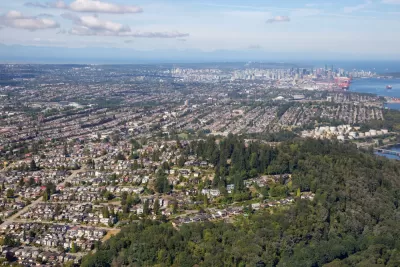If its proposals are effectively implemented, Vancouver's new housing plan would promote 'missing middle housing' and increase density near jobs and transit.

While it has taken years for Vancouver's city council to develop the framework for a plan to increase housing density and provide more affordable housing in the city, the Globe and Mail editorial board sees the recently released plan as a step in the right direction for a city where housing costs have doubled in the last decade.
The board blames Vancouver's widespread single-family zoning for the rise in housing costs and argues that pushing people farther away from jobs and services in the central city could be a hindrance to Vancouver's economic growth. Some homeowners, however, are ready to fight the city's plans to increase density in residential neighborhoods. Meanwhile, housing advocates say permitting density only on busy arterial roads, which expose residents to higher levels of pollution and noise, discriminates against low-income households.
According to the editorial, the proposal focuses on encouraging "missing middle housing" and mixed-use development, but does not yet include specific provisions for zoning changes.
More than 50 per cent of Vancouver’s land is devoted to just 15 percent of the city’s housing. The draft plan has ideas to increase development near rapid transit and shopping areas, but it is the proposal to allow more types of housing in neighbourhoods of detached single-family homes that likely will make the biggest difference in the decades ahead.
The council expects to vote on a finalized plan in mid-2022.
FULL STORY: Vancouver has a plan for the future of Canadian cities

Alabama: Trump Terminates Settlements for Black Communities Harmed By Raw Sewage
Trump deemed the landmark civil rights agreement “illegal DEI and environmental justice policy.”

Planetizen Federal Action Tracker
A weekly monitor of how Trump’s orders and actions are impacting planners and planning in America.

The 120 Year Old Tiny Home Villages That Sheltered San Francisco’s Earthquake Refugees
More than a century ago, San Francisco mobilized to house thousands of residents displaced by the 1906 earthquake. Could their strategy offer a model for the present?

In Both Crashes and Crime, Public Transportation is Far Safer than Driving
Contrary to popular assumptions, public transportation has far lower crash and crime rates than automobile travel. For safer communities, improve and encourage transit travel.

Report: Zoning Reforms Should Complement Nashville’s Ambitious Transit Plan
Without reform, restrictive zoning codes will limit the impact of the city’s planned transit expansion and could exclude some of the residents who depend on transit the most.

Judge Orders Release of Frozen IRA, IIJA Funding
The decision is a victory for environmental groups who charged that freezing funds for critical infrastructure and disaster response programs caused “real and irreparable harm” to communities.
Urban Design for Planners 1: Software Tools
This six-course series explores essential urban design concepts using open source software and equips planners with the tools they need to participate fully in the urban design process.
Planning for Universal Design
Learn the tools for implementing Universal Design in planning regulations.
Clanton & Associates, Inc.
Jessamine County Fiscal Court
Institute for Housing and Urban Development Studies (IHS)
City of Grandview
Harvard GSD Executive Education
Toledo-Lucas County Plan Commissions
Salt Lake City
NYU Wagner Graduate School of Public Service





























